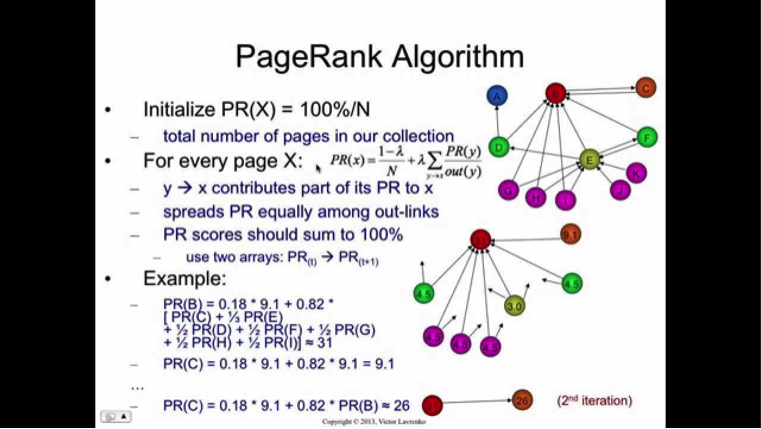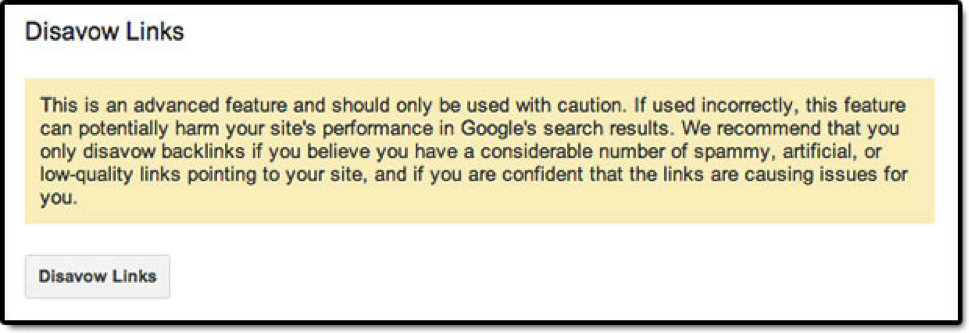Basic Understanding of Google’s Disavow Tool
 The Disavow tool is part of the Google Search Console, previously known as Webmaster Tools, that allows websites to discount the value of an inbound link. This helps to prevent against link-based penalties.
The Disavow tool is part of the Google Search Console, previously known as Webmaster Tools, that allows websites to discount the value of an inbound link. This helps to prevent against link-based penalties.
In layman’s terms, Google’s Disavow Tool is Google’s own way of allowing you to ask Google not to count certain incoming links that come to your site. The tool is primarily used to prevent “bad” links from tarnishing the site’s reputation. If there are even a few of these “bad” links directing consumers to your site they can negatively affect your search engine rankings, which in turn is bad for business overall and is difficult and time consuming to rebuild that level of good standing.
You should first try to clean up all unnecessary links pointing to your site but Google created its Disavow Tool, as an advanced tool to help you deal with the rest of the problem links. Check out some examples and get a further understanding here. https://support.google.com/webmasters/answer/2648487
And implement the tools by following the steps outlined below
https://www.google.com/webmasters/tools/disavow-links-main
Why do Online Businesses Disavow Links?
“Bad” links can occur in a multitude of accidental and purposeful ways. A competitor can create them to deliberately devalue your site and move you further down the rankings list, thus moving their own site above yours and increasing their visibility casinoluck and their profitability, while you are inadvertently suffering.
Users may accidentally create these harmful links by posting content about their own site on an un-reputable site, thinking that they are promoting their brand, but in reality it is backfiring.
An SEO expert may have inadvertently created these “bad links” when assisting with your website setup or the algorithms associated with Google may have changed so the formerly useful link now becomes an issue.
Online Businesses primary reason to disavow links is to protect the site and its reputation and its ranking on the Search Engine Results Page. An online business’ priority is to be easily found, recognized and to be thought of as reputable and positive backlinks can assist in promoting their good reputation, whilst “bad links” can really damage it.
Whatever their cause, bad links hurt companies and Google’s disavow tool is one efficient and effective way to stop the damage from continuing.
What about PageRank?
PageRank is an oft discussed tool among Search Engine Optimization (SEO) experts and is clearly defined and discussed in the link below.. http://www.cs.princeton.edu/~chazelle/courses/BIB/pagerank.htm
PageRank is an important factor in helping Google form its opinion of your site based on the quality of incoming links from other sites. It is an algorithm that Google search uses to rank websites in their search engine results. It measures the importance of pages on websites.

It is named after one of Google’s founders, Larry Page. Google uses PageRank and about two hundred other tools in making its determination of a quality ranked site. A positive incoming link to your site is the equivalent of a vote of confidence for your site. Google provides quality control by ensuring that third party sites’ links do not negatively affect a website.
This isn’t always failsafe and when “bad” links or paid links to your site violate Google standards and you can’t get rid of them yourself, only then is it time to turn to the professional method of using the Disavow Tool.
Penguin Updates Explained
 Google launched its initial Penguin update on April 24th of 2012 to better catch sites that were seemingly spamming its search results. Spam, in this case, is considered to be when people are deliberately “keyword stuffing” or “cloaking” and are deliberately violating Google’s guidelines and policies.
Google launched its initial Penguin update on April 24th of 2012 to better catch sites that were seemingly spamming its search results. Spam, in this case, is considered to be when people are deliberately “keyword stuffing” or “cloaking” and are deliberately violating Google’s guidelines and policies.
It especially targeted those that were buying links or obtaining the links from link networks that were designed primarily to boost kiwi gambling Google rankings. Many site owners were struggling over what to in the wake of Penguin updates and we found that although it can be confusing, the following tips simplify things.
When a new Penguin update is released, sites that have taken actions to remove bad links and to prevent spam, such as with manual removal of back links or with the Disavow tool, may regain their rankings.
However, new sites, that were not previously caught by a tool or manually, may get trapped by the Penguin update and sites that were caught by mistake, also known as “false positives” may escape capture. A Penguin update can take a few days to become fully live and in the meantime search results are impacted since it hasn’t fully rolled out over all of Google’s products.
 When the rollout is complete, Google confirms that Penguin is updated and is now considered to be fully live. Google does report some of its spamming offenses to https://www.google.com/webmasters/#?modal_active=none
When the rollout is complete, Google confirms that Penguin is updated and is now considered to be fully live. Google does report some of its spamming offenses to https://www.google.com/webmasters/#?modal_active=none
but there is no sure fire way to know if the Penguin Update hit you. If you see a major drop in search traffic on your site immediately after the Penguin update, when compared with a couple of days before, then it did affect you. If you don’t see any difference then there is probably nothing to worry about and you weren’t impacted. If your traffic increased after the Penguin update then you most likely benefited from it.
It is said, by industry experts, to be much easier to recover from Penguin updates if your site earns new and diverse links from high quality, reputable sites. Rather than worry about the what if’s, take this “Google approved” advice and rest assured that the professionals are handling the Penguin.
How to Use the Disavow Tool and What Mistakes to Avoid
Disavow is an often misused and difficult to understand tool unless you are Matt Cutts or another Google representative that understands its inner workings. Out of all of the Google products, this one definitely scares the most people with the fear of the unknown, incessant rumors about it and user’s stories of inconsistent results. Keep in mind that Google wants you to remove the links first and only use Disavow as a last resort! It even has a warning box seen here.
Don’t sabotage your site by disavowing too much and then completely wiping out your site traffic and having to build up your followers again and having to wait to go back up in rankings. Be careful when disavowing so as not to undo all the hard work you initially out into promoting and linking your site for positive web exposure.

When dealing with blogging platforms like wordpress.com, blogger.com and blospot.com make sure to disavow a specific subdomain and not the entire domain since the subdomain is where the issue lies in these sites.
You don’t want to disavow all these entire domains because then you are asking Google to cancel out the value that these platforms bring to your site overall. Try to differentiate between the spam blogs leading toward your site and the authentic blogs pointing to your site.
You are going to follow a similar process in using the Disavow Tool whether Google sent you a penalty and flagged your website, dropping you in their ranks, or if you are just performing routine website maintenance.
1. First, it is imperative to gather all of the incoming links to your website, also known as backlinks. You can easily do this by creating a list of your links from Google Search Console https://www.google.com/webmasters/tools/home?hl=en

and you can also use other tools such as Ahrefs, BackLink History or Open Site Explorer and then combine the results making sure that you have all the incoming links accounted for. It’s recommended that you select at least two of the above mentioned tools to help you compile the most accurate list possible.
You can do this manually by putting the links into a Microsoft Excel Spreadsheet and checking them one by one which can be time consuming.
Avoid overlooking links and don’t discount a site just because it isn’t as well-known as other sites. If a link is sensible and relevant then there’s usually no need to eliminate it. This article shows what links not to disavow. https://searchenginewatch.com/sew/how-to/2360254/is-that-directory-link-unnatural If a link seems suspicious or fraudulent then those definitely need to be removed.
or you can use a tool like http://www.linkresearchtools.com/ to do it for you. This is a complete link data platform that provides fresh and accurate link data without all the time consumption. It can even remove a Google penalty and help you regain lost organic site traffic.
2. Next, make a text file of all the links you want to include for Disavow and save it. You can decide to get rid of the entire domain or just one of its links depending on which is the problem factor. Go to the Google Disavow Tool and upload the selected link or domain name that you want to discard. Once it is completed, you will get a confirmation message in the tool and via email that it has been uploaded.
3. If Google issued you a penalty, then they want to see that you have made a concerted effort to get rid of the list of “bad” links. This process of link removal outreach should not be skipped.
Some resources for link removal outreach are:
http://www.buzzstream.com/
rmoov
Remove’em
You will need to provide a list of the links and sites, which can be done in the above mentioned Excel spreadsheet, and notes about the times you attempted to contact them to have them removed, and what your results were. Did the site owners respond to you? How many times did you contact them? Did they get removed or does Google still need to step in? Don’t make the mistake of ignoring this step. Google is more likely to give you a favorable outcome after you show them your evidence of attempts on your own.
Make sure your notes are legible and detailed so if questions arise or if you accidentally disavow the wrong site you can rely on your notes for why you felt that way and what actions were taken and what was the issue with the backlink at the time. Use Google docs as a way to submit your requests because it will most likely be looked at sooner and better protected than submitting them as individual links, which the team at Google may not click on, thus hindering the process even more.

Google rejects many disavow files due to bad formatting, which many developers and site owners don’t even know about. Follow the Google submission guidelines of submitting file types of .txt only and they must be encoded: UTF-8 or 7-bit ASCII
Note: It is so important to do routine monthly website maintenance, especially on high traffic websites like e-commerce sites, to save time and money and keep your hard earned ratings up. Keep in mind that this is not an overnight solution and it may take one to twelve months after using Google’s Disavow tool to see your ratings go back to status quo, or to hopefully climb even higher than they were before.
You are likely to go through the frustrating process of filing reconsideration requests and these can take in excess of two months. Be patient, follow the process, reach out to resourceful sites for help and realize that it’s not the end of the world.
Conclusion
In conclusion, Google’s Disavow tool is cumbersome but useful. Today, it is difficult for a SEO to keep up with what is considered a “bad link” or what is a “good link” and despite that difficulty, Google still cracks down on the “bad links.” Successful internet marketers find it much more fulfilling to build new links rather than disavowing old ones. This goes along with Google’s point of using the Disavow tool as a last resort measure, and not a first choice.
To disavow or not to disavow…that is the question!
Good luck and let us know in the comments section how your experience was and what the results were when dealing with Google’s Disavow Tool!
If you need help with disavowing links please contact us for a free consultation:
Gary G. Guerrero is an internet marketing expert that operates GGG Marketing LLC. He works with small local businesses and large internet based companies. In addition, he has a highly successful internet business that publishes e-products, learning products, and has helped thousands of people learn and improve their own internet marketing strategies.
About us and this blog
We are a digital marketing company with a focus on helping our customers achieve great results across several key areas.
Request a free quote
We offer professional SEO services that help websites increase their organic search score drastically in order to compete for the highest rankings even when it comes to highly competitive keywords.
Subscribe to our newsletter!
Recent Posts
- Common Mistakes Made with Google’s Disavow Tool January 9, 2017

Pingback: Medicinal Chemistry
Pingback: Transfer students admissions to future university
Pingback: future unversity in egypt news
Pingback: fue
Pingback: خطوات التقديم بالكلية
Pingback: Fast-paced and constantly changing labor market
Pingback: Quality of life
Pingback: Letters of recommendation for future university
Pingback: تحويل قبول الطلاب إلى جامعة المستقبل
Pingback: صور التخرج لطلاب جامعة المستقبل بمصر
Pingback: future university accredited